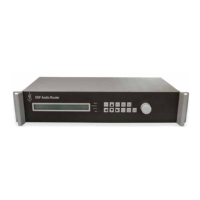VAR8 and Variants Operation, Commissioning, Fault Finding, and Maintenance Guide
sue: 02 complete, approved
-
Is
Page 70 of 166
8. Define the time over which this audio channel is faded up/down when audio sources change.
A slow fade up time is desirable for music inputs.
Menu: ConfigurationÆSystemÆRouterÆInputsÆMic/LineÆI/P #<nn>ÆAudioÆFade
L
• A slow fade up time is desirable for music inputs.
• The time is given in tenths of a second, so divide by ten for the time in seconds.
• It is important for Fire Microphones to be able to override other sources quickly;
therefore Fire Microphones are set-up for a short Fade Down time.
The Fade Down time is:
• The time it takes for the signal to fade down when turned off (un-routed);
• The time it takes for the signal to fade down before an overriding broadcast is made in its place
The Fade Up time is the time the signal takes to fade up when:
• Turned on (routed);
• Override removed.
This can be set to provide the desired changeover fading, e.g. when a broadcast interrupts background
music, or a lower priority broadcast.
The diagram in Figure 5 illustrates the sequence of events during the enabling and disabling of a single
audio source (e.g. background music).
Figure 7 Sequence of Events for Single Audio Source
MUSIC
FADE UP=T1
FADE DOWN= T2
T1
MUSIC AUDIO
T2
ON
OFF
The diagram in Figure 6 illustrates the sequence of events during the override of a background music
source by a Paging Microphone with chime.
Note that the background music Fade Down time (T2) not used in this instance. Instead the microphone
Fade Down time (T4) is used.

